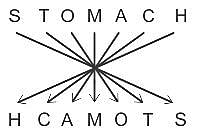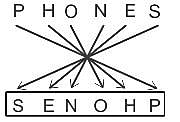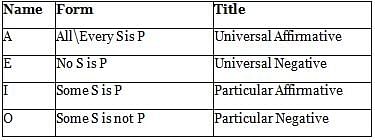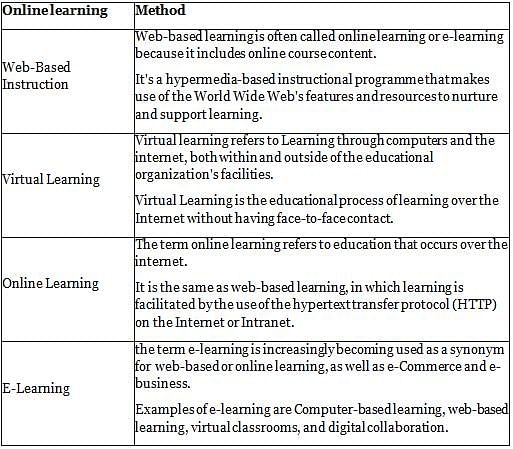TS SET Paper 1 Mock Test - 1 - TS TET MCQ
30 Questions MCQ Test TS SET Mock Test Series 2024 - TS SET Paper 1 Mock Test - 1
A trader marks his goods 40% above the cost price and gives the discount of 20% on it. What is the profit percentage?
Match List I with List II gives their characteristic features.
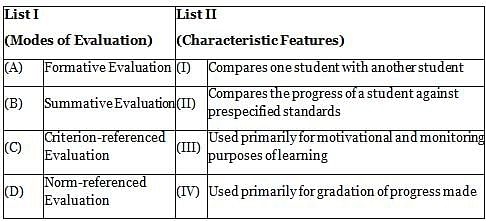
Choose the correct answer from the options given below :

Choose the correct answer from the options given below :
If a researcher conducts a research on finding out which administrative style contributes more to institutional effectiveness, it will be an example of
Directions: Read the following passage carefully and answer the question.
The phrase “What is it like?“ stands for a fundamental thought process. How does one go about observing and reporting on things and events that occupy segments of earth space? Of all the infinite variety of phenomena on the face of the earth, how does one decide what phenomena to observe? There is no such thing as a complete description of the earth or any part of it, for every microscopic point on the earth’s surface differs from every other such point. Experience shows that the things observed are already familiar, because they are like phenomena that occur at home or because they resemble the abstract images and models developed in the human mind.
How are abstract images formed? Humans alone among the animals possess language; their words symbolise not only specific things but also mental images of classes of things. People can remember what they have seen or experienced because they attach a word symbol to them.
During the long record of our efforts to gain more and more knowledge about the face of the earth as the human habitat, there has been a continuing interplay between things and events. The direct observation through the senses is described as a percept; the mental image is described as a concept. Percepts are what some people describe as reality, in contrast to mental images, which are theoretical, implying that they are not real.
The relation of Percept to Concept is not as simple as the definition implies. It is now quite clear that people of different cultures or even individuals in the same culture develop different mental images of reality and what they perceive is a reflection of these preconceptions. The direct observation of things and events on the face of the earth is so clearly a function of the mental images of the mind of the observer that the whole idea of reality must be reconsidered.
Concepts determine what the observer perceives, yet concepts are derived from the generalisations of previous percepts. What happens is that the educated observer is taught to accept a set of concepts and then he/she sharpens or changes these concepts during a professional career. In any one field of scholarship, professional opinion at one time determines what concepts and procedures are acceptable, and these form a kind of model of scholarly behaviour.
Q. According to the passage, human beings have mostly in mind
Match List I with List II.
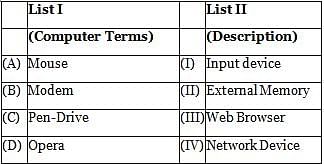
Choose the correct answer from the options given below:
Directions: Read the following passage carefully and answer the question.
The popular view of towns and cities in developing countries and of urbanisation process is that despite the benefits and comforts it brings, the emergence of such cities connotes environmental degradation, generation of slums and squatters, urban poverty, unemployment, crimes, lawlessness, traffic chaos etc. But what is the reality? Given the unprecedented increase in urban population over the last 50 years from 300 million in 1950 to 2 billion in 2000 in developing countries, the wonder really is how well the world has coped, and not how badly.
In general, the urban quality of life has improved in terms of availability of water and sanitation, power, health and education, communication and transport. By way of illustration, a large number of urban residents have been provided with improved water in urban areas in Asia’s largest countries such as China, India, Indonesia and Philippines. Despite that, the access to improved water in terms of percentage of total urban population seems to have declined during the last decade of 20th century, though in absolute numbers, millions of additional urbanites have been provided improved services. These countries have made significant progress in the provision of sanitation services too, together, providing for an additional population of more than 293 million citizens within a decade (1990-2000). These improvements must be viewed against the backdrop of rapidly increasing urban population, fiscal crunch and strained human resources and efficient and quality-oriented public management.
Q. Which of the following statements cannot be inferred from the given passage?
Which one of the following is considered a sign of motivated teaching?
Directions: Study the following information and answer the question that follows.
The percentage of employees in various departments in company A is as shown below.
There are 1800 employees in total.
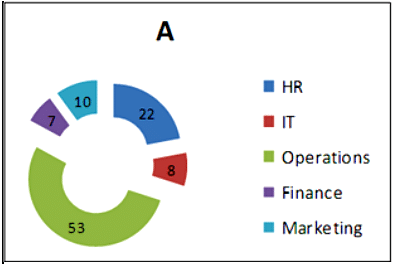
Q. If 30 more people join the Operations department, then what will be the percentage of employees in the Operations department?
Directions: Study the given information and answer the following question.
The line graph shows the incentive points earned by four salespersons in different months of 2017.
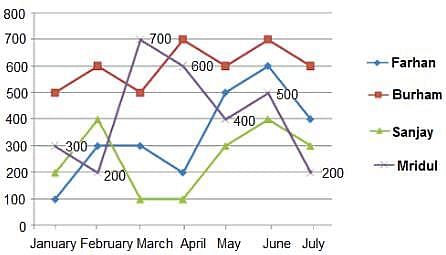
Q. Which salesperson(s) earned the second-highest points during the given period?
The South Asia University is situated in the city of
In a certain code language, 'STOMACH' is written as 'HCAMOTS'. How will 'PHONES' be written in that language?
Match List I with List II:
Consider the following in the context of the Square of Opposition of Propositions:

Choose the correct answer from the options given below:
What is the basis on which assumptions are formulated?
Which of the following problems is related to classroom management?
If a researcher conducts a research on finding out which administrative style contributes more to institutional effectiveness? This will be an example of__________.
A computer program that translates a program statement by statement into machine language is called a/an
Research has shown that the most frequent symptom of nervous instability among teachers is
Which of the following is true about the National Mission in Education through ICT (NMEICT)?
- It is a centrally sponsored scheme to enhance Gross Enrollment Ratio in higher education by making use of ICT.
- The two major components are providing access and content generation.
The essential quality/qualities of a researcher is/are
Direction: Read the passage carefully and choose the best answer to each question out of the four alternatives.
It is not good manners to stop a person on the street or in a shop, or in the performance of any duty and to talk to him for ten, fifteen, or twenty minutes just to pass the time of day. We can tell that a person is in a hurry to get somewhere, or he is doing something, and we know enough not to interrupt him for any length of time. Yet some of us think nothing of calling someone on the telephone, interrupting him without a thought about what he may be doing, and chattering away, forgetting about time or anything else. Perhaps we don’t consider our telephone conversation an interruption because we don’t see what we have interrupted. Naturally, we must observe the common courtesies over the telephone. But we must remember that one of the courtesies of telephoning is to be brief.
Never ask anybody to guess who you are? The person you are telephoning may not be in a guessing mood. If you know him, you may want to ask after the state of his health and that of his family, but as soon as you possibly can, go get on with your business. He certainly wants to know why you are telephoning him. When you are finished with your business, you might take moment to observe the natural courtesies of conversation, expressing your thanks before ending your call.
From the way the telephone is used in your home, you would hardly suspect that this is an instrument on which very important business transactions are conducted. There are times when even you are called upon to be business-like, brief, and effective on the telephone.
Q. How can we make the best use of a telephone?
In which of the following Ancient Indian universities, the culture and civilization of Tibet was built mainly through the writings of the scholars?
Manuel Castelle was the first to use which of the following terms?
The population information is called parameter while the corresponding sample information is known as
Directions: Read the given passage carefully and answer the following question:
Heritage conservation practices improved worldwide after the International Centre for the Study of the Preservation and Restoration of Cultural Property (ICCROM) was established with UNESCO’s assistance in 1959. The inter-governmental organisation with 126 member states has done a commendable job by training more than 4,000 professionals, providing practice standards, and sharing technical expertise. In this golden jubilee year, as we acknowledge its key role in global conservation, an assessment of international practices would be meaningful to the Indian conservation movement. Consistent investment, rigorous attention, and dedicated research and dissemination are some of the positive lessons to imbibe. Countries such as Italy have demonstrated that prioritising heritage with significant budget provision pays. On the other hand, India, which is no less endowed in terms of cultural capital, has a long way to go. Surveys indicate that in addition to the 6,600 protected monuments, there are over 60,000 equally valuable heritage structures that await attention. Besides the small group in the service of Archaeological Survey of India, there are only about 150 trained conservation professionals. In order to overcome this severe shortage, the emphasis has been on setting up dedicated labs and training institutions. It would make much better sense for conservation to be made part of mainstream research and engineering institutes, as has been done in Europe.
Increasing funding and building institutions are the relatively easy part. The real challenge is to redefine international approaches to address local contexts. Conservation cannot limit itself to enhancing the art-historical value of the heritage structures, which international charters perhaps overemphasise. The effort has to be broad-based: It must also serve as a means to improving the quality of life in the area where the heritage structures are located. The first task, therefore, is to integrate conservation efforts with sound development plans that take care of people living in the heritage vicinity. Unlike in western countries, many traditional building crafts survive in India, and conservation practices offer an avenue to support them. This has been acknowledged by the Indian National Trust for Art and Cultural Heritage charter for conservation but is yet to receive substantial state support. More strength for heritage conservation can be mobilised by aligning it with the green building movement. Heritage structures are essentially eco-friendly and conservation could become a vital part of the sustainable building practices campaign in future.
Q. The inter-government organisation was appreciated because of
Match List I with List II.
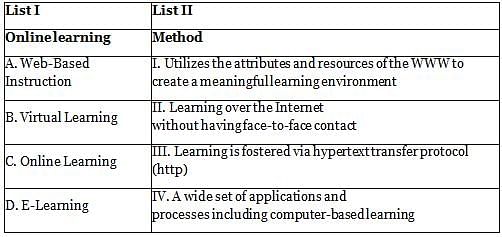
Choose the correct answer from the options given below:
Environmental education should be taught in schools because
|
60 tests
|






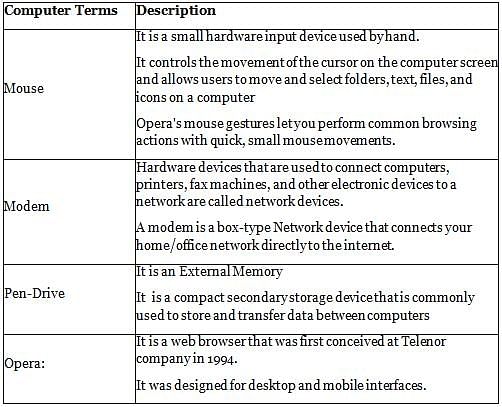
 = 954
= 954